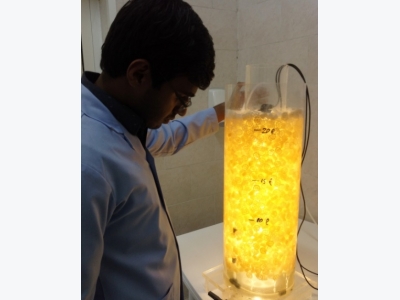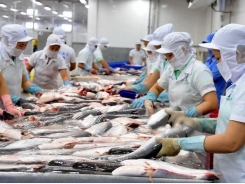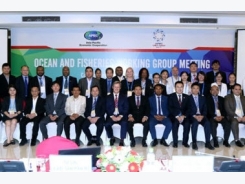Novel reactor developed for indoor, high-density production of diatoms

In situ feed production applicable for desert, saline pond aquaculture
The intra-luminic, photosynthetic, cylindrical reactor.
In the Middle East Region, according to Dr. Nyan Taw, a standard biofloc protocol (on a careful balance between autotrophic and heterotrophic organisms) had to be adapted to suit the extreme desert, Red Sea environmental conditions — high salinity and temperature. Colloidal carbohydrates from Amphora are excellent carbon sources for heterotrophic bacteria. The mucilage metabolites of the benthic diatoms promote Vitamin B12-producing, benign bacteria, possibly aiding to improve L. vannamei gut health. And algae-bacteria interactions produce soluble factors from Amphora that could resist harmful algae. Its tolerance to Tributyltinfluoride and Copper have been reported as early as 1987 in British Columbia and the rapid metabolism of polycyclic aromatic hydrocarbons detected by National Center for Toxicological Research, Arkansas even three decades back.
The functional abundance of “enzymatic digests of Amphora” as natural antioxidant activity in Amphora were thoroughly studied earlier in Cheju National University, Korea. The accumulation and release of polysaccharides by planktonic cells and the subsequent bacterial responses are well-known. Exopolysaccharide release and epibiotic bacteria and bacteriostasis are reflex stimuli that occur in aquatic ecosystems. Benthic diatom-induced humic floccule matter also ensures strong microbial adhesion efficiency against floc breakages.
The aquaculture industry in desert regions can benefit significantly from the nutritional and therapeutic properties of Amphora. Extracting an optimal exopolysaccharide (EPS) output from benthic diatom film manipulation is crucial in shrimp pond ecosystem, facilitating synergistic/coordinated actions between Amphora, for example and the associated bacterial flora (with Actinobacteria as principal dominants). General bio-filming periphyton and hypoliths (cryptic microbial assemblages) act as balanced nourishment for shrimp.
Amphora diatoms

Controlled blooming of suspended/non suspended diatoms in a desert-saline shrimp pond.
With more than 1,000 species, the genus Amphora is a major one for both freshwater and marine diatoms. Species of this diatom are typically cultured in sea cucumber hatcheries as feed for these animals, using conventional cultivation in the form of bath immersion of normal, laminar acrylic panels. Decades back, the shrimp farming pioneers in South American hatcheries looked at various brush systems in polycarbonate tanks, but eventually decided it was easiest to simply bloom commercial Aquamats (Meridian Aquatic Technology) in tanks with Amphora and then move the mats to the shrimp postlarvae (PL) tanks. Shrimp hatcheries have increased their stocking densities, improved PL survival and growth, and produce larger average sizes and get improved stress test results and overall increased production using species of Amphora. Khatoon et al. (2009) have found naturally-engineered, periphytic Amphora, Navicula and Cymbella substrates as feed supplements in black tiger shrimp (Penaeus monodon) post-larval hatchery system. The contribution of several species of diatoms (Amphora, Cylindrotheca, etc.) to the lipid content of biofloc and the performance of juvenile Pacific whiteleg shrimp (Litopenaeus vannamei) have been recently reported (Martins et al., 2014).
An indoor photosynthetic reactor for Amphora
The objective of our work was to create capacity production for a continuous supply of Amphora to ponds from an indoor photosynthetic reactor, by exploiting the diatom adherence abilities on hard substrates (bio-strata wheels). Our test species was the diatom Amphora gamma. Our intra-luminic, photosynthetic, cylindrical captor reactor device consists of two concentric, acrylic tubes put together one inside the other, with a central, hollow chamber bearing a fluorescent tube. The interspacing between the two concentric tubes is 65 mm. The bio-strata wheels are dispersed and fill the 65-mm thin concentric mesocosm with Amphora culture fluid. The plasticity of the bio-strata material helps positioning in the bedded matrix in any convoluted form or disarrayed circle. In the reactor, the micro-roughness and micro-architectural, miniature laminar sub-layers of the bio-strata wheel serve as bio-adhesion capacitors. Improvising bio-strata wheels as fluidized bed produces an efficient accumulation of Amphora biomass. The 20-L reactor has the capability to hold a stock of more than 150 billion cells.
Inter-cellular communication amongst sister cells would reflect on Amphora cell physiology too, with cell clustering, cell pigmentation, stress proteins, anti-oxidants, and differential expression of molecular mechanisms such as osmolytes, mycosporine-like aminoacid compounds, etc. Hyper illumination-induced hyper locomotion makes the diatoms jolt or twitch, which enhance the biofilm porosity and effective diffusion coefficient.

Bio-filming, bio-strata wheel (with Amphora biofilm — darker coloration, on the left one).
The development of this reactor for the indoor cultivation of non-suspended microalgae and the cellular dry matter values produced in our study will help bio-filming science support the development and improvement of in situ feed supplementation for fish and shrimp ponds.
Growing microalgae as probiotic biofilms
The heterogeneous structure of the Amphora biofilms on the bio-strata wheel permits advective transport of nutrients within it and into the culture water micro-channels permeating through the biofilm. Dolomite addition to the photosynthetic culture helps the process, and at the cost of just a mild pH drop from 8.3 to 7.6. Calcium sulfate aids clustering or colony formation of Amphora due to internal regulation.
By growing algae as a biofilm, there is much potential to significantly reduce these costs because the biomass is immobilized and much more concentrated – 0.4 percent (g/g) for planktonic systems, compared to 8 to 16 percent in biofilms. This immobilized nature may also make downstream processing easier and more economical. Species of Amphora are excellent food for many gastropod molluscs and sea urchins. The addition of cultured diatoms such as Amphora sp. offers greater control for intensive abalone nurseries. Nominal feed utilization and increased growth due to Amphora floc consumption by L. vannamei shrimp is an asset. Thirty-seven percent protein and 27 percent lipid are characteristic of Amphora gamma.
Perspectives
To date, there was only limited experience in cultivating benthic diatoms in desert-saline waters. Our reactor — even at its relatively small-scale — and study results help identify many key knowledge gaps on the potential for producing cell biomass from algae biofilm growth systems. It also points the way to commercial production trials in the future, to incorporate this technology into and help with feed production for aquaculture production systems in desert environments.
References available from first author.
Related news
Tools

Phối trộn thức ăn chăn nuôi

Pha dung dịch thủy canh

Định mức cho tôm ăn

Phối trộn phân bón NPK

Xác định tỷ lệ tôm sống

Chuyển đổi đơn vị phân bón

Xác định công suất sục khí

Chuyển đổi đơn vị tôm

Tính diện tích nhà kính

Tính thể tích ao



 Strong growth seen in global shrimp market
Strong growth seen in global shrimp market  APEC’s action plan for sustainable fisheries discussed
APEC’s action plan for sustainable fisheries discussed